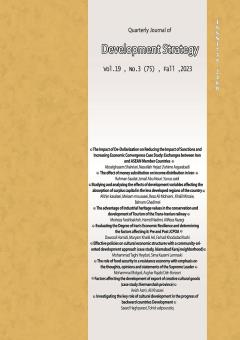Factors affecting the development of export of creative cultural goods (case study: Kermanshah province)
Subject Areas :Aeizh Azmi 1 * , Ali Khazaei 2
1 -
2 - Department of Geography, Faculty of Literature and Humanities, Razi University, Kermanshah, Iran
Keywords: Keywords: export of creative and cultural industries, non-oil goods, export development, Kermanshah province.,
Abstract :
Aeizh Azmi Ali Khazaei Abstract Diversifying the export of non-oil goods has been one of the goals of the country's economists and planners; However, among non-oil goods, little attention has been paid to the capabilities of exporting creative cultural goods, which this article aims to investigate the factors affecting the export of non-oil goods. The research method was applied, descriptive, analytical and using a questionnaire tool. The sampling method was simple. The statistical population consisted of 343 artists in the fields of painting, drama, calligraphy, graphics, books, and written press. The research sample using Cochran's formula was equal to 182 people. The reliability of the research was confirmed by Cronbach's alpha with an average of 0.79. The validity of the research was also confirmed using the opinion of sociology and art experts. The findings show that 7 components of legal factors, international issues, domestic challenges, production challenges, educational factors, economic challenges and characteristics of creative industries are effective on the export of cultural creative industries. The results of the regression show that the factors Laws are the most important obstacle to the export of creative cultural products. Second, international issues and domestic production challenges have been introduced as the most important legal obstacles to the export of creative industries. Finally, the findings of the Kruskal Wallis test show that there is no significant difference between the cultural challenges of exporting creative cultural goods. In other words, despite the substantial differences between creative and cultural industries, their export challenges are similar and to solve a large part of their problems, general and similar policies can be adopted.
منابع
- بوردیو، پی یر. تمایز، نقد اجتماعی قضاوت هاي ذوقی. ترجمه حسن چاوشیان. (1390). تهران: نشر ثالث.
- پارک علم و فناوری استان مرکزی(1401)، صنایع خلاق فرهنگی، https://www.astp.ir/page/creative_industires
- حسین زادگان، زهره (1390)، طراحی الگوی توسعه صادرات کالاهای فرهنگی، رساله ی دکتری دانشگاه آزاد اسلامی واحد علوم و تحقیقات تهران.
- خاقانی، معصومه و میرانی، سروش(1390)،،نقش خلاقیت و نوآوری در توسعه صنایع فرهنگی،همایش ملی صنایع فرهنگی نقش آن در توسعه پایدار،کرمانشاه
- رحیمی رهبر، ا.، و خدادادی مترجم زاده، م. (1395). چالش عناوین و مصادیق عکاسی خلاق و هنری در عکاسی معاصر ایران با تمرکز بر دوسالانه های عکاسی نهم (1383) و یازدهم (1387). هنرهای تجسمی (هنرهای زیبا)، 21(1)، 61-73.
- رزقی شیرسوار، هادی؛ عمرانی صباغی، محمد حسین. (1392). راهکارهای توسعه ی صادرات کالاهای فرهنگی درعصر جهانی شدن، مطالعات راهبردی سیاستگذاری عمومی، 4(11)، 41-72.
- سپهر نیا، رزیتا؛ دلاور، علی؛صالحی امیری، سید رضا(1391)، بررسي جايگاه و رابطه صنايع فرهنگي خالق در ارتقاء سرمايه فرهنگي در ايران، ابتکار و خلاقیت در علوم انسانی، 2(5)، 165-143.
- شوال پور آرانی، سعید، کهنی، علی. (1394). بررسی نقش فناوری در توسعه صنایع فرهنگی و خلاق: مطالعه موردی فرش دستبافت ایرانی. مطالعات هنر اسلامی، 11(23), 115-128.
- صالحی امیری، سید رضا، کاوسی، سید اسمعیل، تقدسی، پوراندخت(1389)، بررسی عوامل موثر در صادرات کالاهای فرهنگی در ایران و ارائه راهبردهای مدیریتی، مجله مدیریت فرهنگی، 4(9)، 73-93.
- صالحي اميري، سيدرضا؛ عظيمي دولت آبادي، امير؛ ( 1391)، مباني سياست گذاري و برنامه ريزي فرهنگي، تهران: مجمع تشخيص مصلحت نظام، مركز تحقيقات استراتژيك، چاپ سوم
- ملکی فر، سیاوش. (1397). مهمان سردبیر: چرا صنایع فرهنگی و خلاق رمق ندارند؟ سیاست علم و فناوری، 10(4 )،1-1
- Ball, L. (2003), Future directions for employability research in the creative industries,working paper, Design Council and LTSN, London,available at: www.heacademy.ac.uk/assets/documents/subjects/adm/FutureDirectforEm.pdf
- Bilton, C. (2007). Management and creativity. Oxford: Blackwell.
- EC (2014). INTERREG IVC analysis report — Creative industries. Brussels: European Union Interreg Joint Secretariat.
- Florida, R. (2005). cities and the creative class. Routledge
- Global Entrepreneurship Monitor) GEM(, (2015). Global Entrepreneurship Monitor Report
- Howkins J, 2002, The Creative Economy, Penguin, London
- Howkins, J. (2001). The Creative Economy: How People Make Money from Ideas. Penguin.
- Isenberg, D., (2011). How to foment an entrepreneurial revolution, The Babson Entrepreneurship Ecosystem Project. 10th international Entrepreneurship Forum, Bahrain, January 11, 2011, 3-5p
- Isenberg, D., (2012). Introducing the Babson entrepreneurship ecosystem project, The Babson Global.1-28p
- Martinaitytė E, Kregždaitė R, (2015), the factors of creative industries development in nowadays stage, journal of scientific papers economics & sociology, vol. 8, No 1.2015
- National Information Society Agency, (2013). National Informatization White Paper. NIA
- Peters, M.A. (2010), “Three forms of the knowledge economy: learning, creativity and openness”, Economics, Management and Financial Markets, Vol. 5 No. 4, pp. 63-92
- White D.Steven, Gunasekaran A, (2012), Performance Measures And Metric for the Creative Economy, Benchmarking, An International Journal, Vol. 21 Iss 1 pp. 46 – 61

